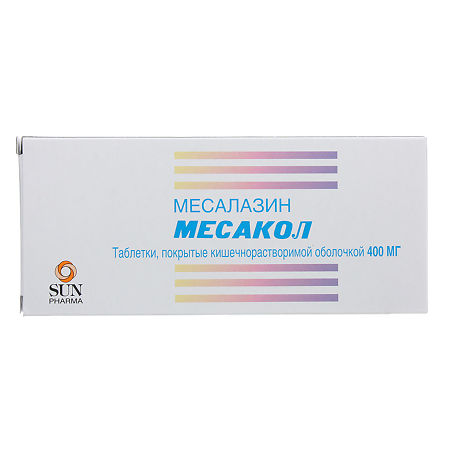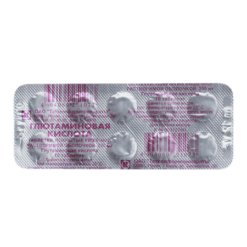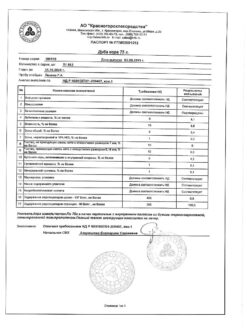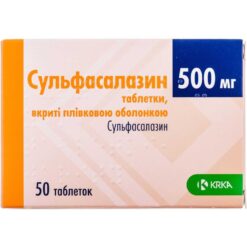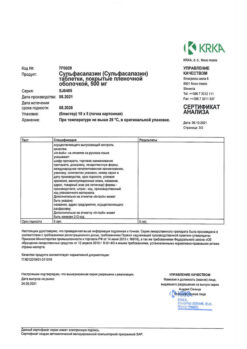No products in the cart.
Mesacol, 400 mg 50 pcs.
€19.57 €16.31
Description
Pharmacodynamics
It has a local anti-inflammatory effect due to inhibition of activity of neutrophil lipooxygenase and synthesis of prostaglandins and leukotrienes. It inhibits migration, degranulation and phagocytosis of neutrophils and secretion of immunoglobulins by lymphocytes.
It has antibacterial action against some cocci and Escherichia coli (manifested in the large intestine).
Pharmacokinetics
After oral administration, mesalazine begins to be released after 110-170 minutes, after 165-225 minutes the tablets are completely dissolved. Due to the presence of a special coating, mesalazine is released mainly in the large intestine (60-79%). In the jejunum 15-30% of the active substance is released, while only about 10% enters the systemic circulation.
The concentration in plasma is low. In the body mesalazine is metabolized to form N-acetyl-5-aminosalicylic acid. Binding to plasma proteins is 43%, and N-acetyl-5-aminosalicylic acid is 73-83%. The drug and its metabolite penetrate into the mother’s milk. Elimination half-life is 0.5-2 hours depending on the dose taken, metabolite – 5-10 hours.
Elevation by the kidneys (50%), through the intestine (40%). Cumulates in chronic renal failure.
Indications
Indications
Non-specific ulcerative colitis, Crohn’s disease (prevention and treatment of exacerbations).
Active ingredient
Active ingredient
Composition
Composition
1 tablet contains as the active ingredient: mesalazine – 400 mg
Excipients:
calcium hydrophosphate dihydrate,
corn starch,
How to take, the dosage
How to take, the dosage
Ingestion. In exacerbations of the disease 1-2 tablets (400-800 mg) 3 times a day for 8-12 weeks.
For prevention of exacerbations 1 tablet (400 mg) 3 times a day is prescribed.
Mesacol tablets should be taken whole, after meals, with plenty of water.
In children, mesalazine is prescribed in the form of suspension, suppositories or microclysters.
Interaction
Interaction
Enhances hypoglycemic effect of sulfonylurea derivatives, glucocorticosteroids ulcerogenicity, methotrexate toxicity.
Allows the activity of furosemide, spironolactone, sulfonamides, rifampicin.
It enhances the effect of anticoagulants and increases the effectiveness of uricosuric drugs (blockers of tubular secretion). Slows the absorption of ciancobapamine.
Special Instructions
Special Instructions
We should keep in mind that diarrhea, which may occur in the background of treatment, is not always a side effect of the drug, but may be a manifestation of the underlying disease.
It is advisable to perform regular general blood tests (before, during, and also after treatment), and urine tests (monitoring of the excretory function of the kidneys). Patients who are “slow acetylators” have an increased risk of developing side effects.
Yellow-orange staining of urine and tear fluid and staining of soft contact lenses may be observed. If the drug is missed, the missed dose should be taken at any time or along with the next dose. If several doses are missed, consult a physician without stopping treatment. If acute intolerance syndrome is suspected, Mesacol should be discontinued.
Because at low pH values the active ingredient is not released from the tablet, Mesacol should not be prescribed simultaneously with drugs that lower the pH.
Contraindications
Contraindications
Hypersensitivity to salicylates and other components of the drug, blood diseases, gastric and duodenal ulcer, glucose-6-phosphate dehydrogenase deficiency, hemorrhagic diathesis, severe renal/liver failure, childhood.
With caution – hepatic and/or renal failure.
Side effects
Side effects
Digestive system disorders: nausea, vomiting, heartburn, diarrhea, especially when using high doses of the drug (but diarrhea is not always a side effect of the drug, but may be a manifestation of the underlying disease); reduced appetite, abdominal pain, dry mouth, stomatitis; increased activity of “liver” plasma transaminases, hepatitis, pancreatitis.
Cardiovascular system disorders: palpitations, tachycardia, arterial hypertension or hypotension, chest pain, dyspnea. There have been some reports of the development of pericarditis and cardiac conduction abnormalities.
Central nervous system disorders: headache, tinnitus, dizziness, polyneuropathy, tremors, seizures, insomnia, depression, hallucinations.
Urogenital system disorders: proteinuria, hematuria, crystalluria, oliguria, anuria, nephrotic syndrome, oligospermia. Individual cases of impotence have been described.
Co of the hematopoietic system: eosinophilia, anemia (hemolytic, megablastic, aplastic), leukopenia, agranulocytosis, thrombocytopenia, hypoprothrombinemia.
Allergic reactions: skin rash, itching, erythema, dermatosis, bronchospasm.
Others: weakness, parotitis, photosensitization, lupus-like syndrome, alopecia, decreased tear fluid production.
Overdose
Overdose
Symptoms: nausea, vomiting, gastralgia, weakness, drowsiness.
Treatment: gastric lavage, administration of laxatives, symptomatic therapy.
Pregnancy use
Pregnancy use
There is currently no clear data on the safety of Mesacol in pregnant women.
Mesacol is administered to pregnant women only if the possible benefit to the woman exceeds the potential risk to the fetus.
When prescribing Mesacol to a nursing woman, breastfeeding should be stopped.
Similarities
Similarities
Additional information
| Weight | 0.058 kg |
|---|---|
| Shelf life | 4 years |
| Conditions of storage | In a place protected from light, at a temperature not exceeding 25°C. |
| Manufacturer | Sun Pharmaceutical Industries Ltd, India |
| Medication form | enteric soluble tablets |
| Brand | Sun Pharmaceutical Industries Ltd |
Related products
Buy Mesacol, 400 mg 50 pcs. with delivery to USA, UK, Europe and over 120 other countries.

